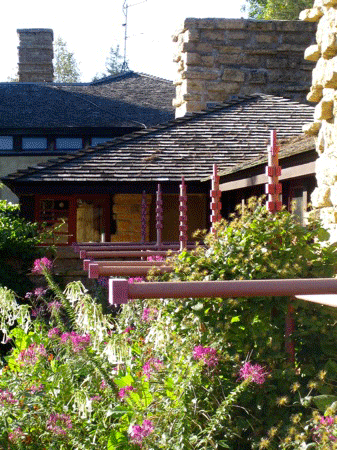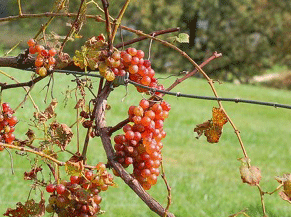 |
|

| Theatrical Oasis |
| Art-chitecture |
| Enchanted Estate |
| Madison Arts Incubator |
| Hand-crafted Healing |
| Designing the Big Day |
| Green Piece |
| Tattoo Taboo? |
| Worth the Wait |
| We Want the Funk |
Art-chitecture: Taliesin through the eyes of Frank Lloyd Wright |
|||||||||||
| Continued... | |||||||||||
A Visionary
“The hardest part is the fact that he experimented with his designs a lot and was changing them all the time,” she said. At the Taliesin site, Wright brings together large panes of glass with a thin line of mortar so as not to obstruct any views of the hills. However, the mortar has started to disintegrate, allowing the external elements to penetrate its surface. "Insulation is an issue with any old house built before 1960," said James Dennis, the owner of Wright's 1936 Jacobs House in Madison. “We improved the radiant heating system back in 1984 by replacing the original cast-iron pipes with polypropylene tubing. There is still heat loss through the sandwich walls whose core boards are wrapped in a tar paper that provides a moisture barrier but little insulation.” Rachelle Messner, a tour guide at the Taliesin Preservation, said she believes Wright would be surprised at the idea that Taliesin has become a museum with tours conducted regularly. “This home was under its third major reconstruction at the time of Wright’s death in 1959, and was constantly evolving with every new idea he had,” Messner said. Fires destroyed parts of Taliesin twice, once in 1914 and again in 1925. Today, Taliesin is often referred to as "Taliesin 3" because of the twice destroyed living quarters. Yet,
Wright did not hesitate to explore with new materials and means of construction, recycling plywood to construct tables and planting old plumbing pipes in his garden as trellises. Wright favored the evolvement of his work and liked to redesign the layout and functions of the space while living there. Until his death in 1959, he never stopped adding to or changing Taliesin and it is known as the longest ongoing architectural project of his career. “Frank Lloyd Wright was a true visionary,” said Murphy. “He was going for a certain look and figured technology would catch up to him. I admire the way he invented means which allowed for his visions and artistic impulses to take flight.” Wright was one of the first in his time to install hydraulic water control, which he employed in the waterfalls at the base of the hill to direct the flow of the water toward his gardens and ponds. Taking it a step further, Wright personally took care of eliminating all the brown spotted cows in the Spring Green area. In that way, he would be left with the traditional and according to him, more aesthetically pleasing, black and white cows. His experimentation of altering the landscape blended effortlessly with his designs and architecture. Wright designed the “Bird Walk” at Taliesin, a suspended bridge overlooking the 600-acre estate, for his third wife, Olgivanna, to walk out upon and observe wild creatures from the vantage point of treetops. Always looking at the details, Wright strongly opposed the electrical posts with their strung wires that were eventually erected on his land. Initially, he handed paint buckets to his apprentices with the instructions to paint the posts green so they would blend in better with the surrounding view. Then he went one step further and ordered the lines to be buried underground and out of sight, something that did not become routine in rural America until many years later. An Artist’s Temperament
“I saw the vineyard now on the south slope of the hill, opulent vines loaded with purple, green and yellow grapes,” he wrote. “There were to be strawberry beds, white, scarlet and green over the covering of clean wheat-straw.” Not only did Wright master control of the views of his structures, but he also dictated the way a guest walks into a room by manipulating lighting, the ceiling height and the floor. Emerging into Wright’s master bedroom at Taliesin Preservation Inc. feels as though an artist is presenting his work to each visitor personally. An entire wall of windows at the far end of the room brings in a private view of nature and faces west with spectacular views of a setting sun each night. Not only did Wright design the structure of a house, but he also took it upon himself to design the furniture, the light fixtures, the flooring and the china to be used within that specific dwelling. His influence touched upon each and every aspect of the owner’s life. He even went as far as designing a wardrobe of gowns for a woman living in one of his houses, so she wouldn't clash with the interior decoration while hosting parties. |
|||||||||||
About Us | Contact Us | Business Partners | Archives | Sitemap
Copyright 2007 Curb Magazine

